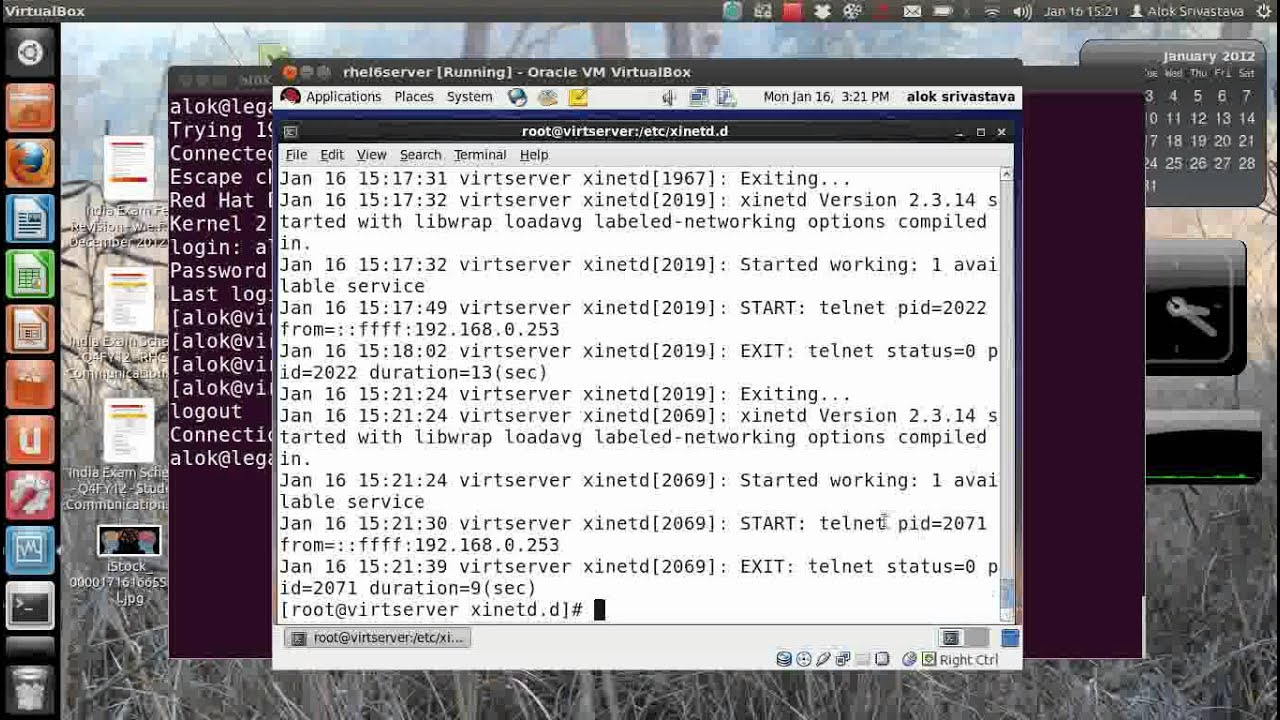Have you ever wondered how your computer manages all the internet services such as FTP, POP3, and Telnet? The answer is xinetd (Extended Internet Service Daemon). xinetd is an open-source super-server daemon that runs on many Unix-like systems and manages all Internet-based connectivity.
xinetd is a more secure alternative to the older inetd (“Internet daemon”), which most modern Linux distributions have deprecated. It offers a number of advantages over inetd, including access control for both TCP and UDP protocols. xinetd performs the same function as inetd: it starts programs that provide internet services.
One of the main advantages of using Xinetd is its security features. It can be used to restrict access to certain services from known IP addresses or networks, and even limit the activity of individual users on those services. Additionally, it can also be used to set up log files for tracking activity, as well as alert administrators when suspicious activity is detected.
In addition to its security features, xinetd also offers other useful features such as resource sharing, allowing multiple service requests to be handled by the same process; server redirection; and advanced logging capabilities. It also provides an easy way for administrators to monitor the usage of each service and make changes if needed.
Overall, xinetd is a great tool for managing internet services on many Unix-like systems. It provides a secure way to keep your computer’s connection safe while providing easy access to important services like FTP and Telnet. If you’re looking for a reliable way to manage your internet connection, xinetd could be just what you need!

Uses of Xinetd
Xinetd is used for managing Internet-based connectivity on Unix-like systems. It provides an alternative to the older inetd service, which is less secure and has been deprecated by many modern Linux distributions. Xinetd supports a wide range of services, including FTP, TELNET, HTTP, and SSH. It can also be used to restrict access to certain services and IP addresses, as well as provide logging capabilities. Furthermore, xinetd allows administrators to enable or disable services easily, without having to manually edit configuration files. As such, it provides an efficient and secure method of managing network connections on Unix-like systems.
Difference Between Xinetd and Inetd
The primary difference between xinetd and inetd is the way they manage Internet-based services. Inetd is a ‘super-server daemon’ that runs on many Unix/Linux systems, and it’s responsible for managing services like FTP, pop3, and telnet. On the other hand, xinetd (eXtended InterNET Daemon) is an open-source daemon that also runs on many Unix/Linux systems but provides extended features such as logging, access control, and resource limits.
Compared to Inetd, xinetd offers more flexibility when configuring services. For example, instead of having to restart the entire server whenever a service needs to be added or removed, with xinetd you can simply add or remove the configuration for that service from one file – making it much easier to manage multiple services at once. Additionally, xinetd can also provide extended access control for each service – allowing administrators to define which IP addresses or users can access each service.
Overall, both xinetd and inetd are powerful tools for managing Internet-based services on Unix/Linux systems – but if you require more flexibility with how your services are configured and accessed then xinetd may be the better option.
Is Xinetd a Secure Service?
Yes, xinetd is a secure daemon. It provides access control for TCP and UDP connections, allowing users to limit access to services based on the source IP address, username/password, time of day, and other criteria. Additionally, xinetd can be configured to run services with the privileges of a dedicated user or group in order to minimize potential security risks. Furthermore, it can be used to log all incoming connection requests and alert administrators if suspicious activity is detected. All of these features make Xinetd a highly secure choice for running network services.
Understanding Xinetd in Ubuntu
Xinetd is an open-source super server daemon for Linux and Unix-like operating systems. It provides a secure, extensible, and configurable framework for starting services on demand. It can be used as a replacement for Inetd, which is the traditional super server daemon used on Unix systems. Compared to inetd, xinetd provides better security, more efficient resource utilization, and improved logging capabilities. Furthermore, xinetd supports access control based on hostname or IP address, time of day restrictions, and limited access to system resources. On Ubuntu systems, xinetd is configured through configuration files located in /etc/xinetd.d directory.
Turning Off Xinetd Services
To turn off xinetd services on Linux, you will need to run the command ‘/etc/init.d/xinetd stop’. This will stop all processes associated with Xinetd and effectively turn it off. It is important to note that this command should be run with root privileges as it requires administrative access. Once the command has been run, you can verify that xinetd is stopped by running ‘ps -ef | grep xinetd’, and there should not be any processes associated with xinetd listed.
Understanding Xinetd and TCPWrapper
Xinetd (Extended Internet Services Daemon) is a super-server that listens on behalf of other services and launches the appropriate daemons when requests are made. It is an enhanced replacement for the inetd daemon, which was used in earlier versions of Linux to manage Internet services. Xinetd provides more features than Inetd, such as access control, logging, and fine-grained service configuration.
Tcpwrapper is a host-based access control system used to restrict access to network services running on a server machine. It uses two configuration files called /etc/hosts.allow and /etc/hosts.deny to specify which hosts or networks can access services running on the server. Tcpwrapper works by intercepting incoming connections before they reach the actual service, so it can be used with any service that runs on a system.
The Benefits of Using Inetd as a Super-Server
Inetd is referred to as a Super-Server because it is an efficient, cost-effective way of handling network connections for multiple services. When Inetd is running, it listens for incoming connection requests on the configured ports and then starts the appropriate service to handle that request. This is more efficient than starting each individual service and having them all listen for connections on their own. In addition, since inetd uses fewer system resources than running multiple services at once, it can help save memory and computing power. Finally, since inetd can be configured to only start certain services when they are needed, it can also reduce security risks associated with running unnecessary services. All these benefits make Inetd an ideal choice as a Super-Server.
Checking if Xinetd is Installed on Linux
To find out if xinetd is installed on your Linux system, you can use the terminal command ‘ps ax | grep inetd’. This will display a list of the processes currently running on your machine. If you see any references to xinetd, then it is installed and running on your system. You can also check for specific services that may be running through xinetd by using the command ‘grep -r xinetd /etc/xinetd.conf’. This will search through the configuration file for any services which are controlled by xinetd.
Configuring the Xinetd Daemon
The xinetd daemon is configured by two files: /etc/xinetd.conf and the files in the /etc/xinetd.d/ directory. /etc/xinetd.conf is the global xinetd configuration file, which contains settings that apply to all services handled by xinetd. The /etc/xinetd.d/ directory contains service-specific files, each of which defines specific settings for a particular service handled by xinetd. By configuring these two files, users can customize various settings for how the Xinetd daemon works on their system.
Restarting Xinetd on Linux
Restarting Xinetd on a Linux system is relatively easy. To begin, make sure that you are logged in as root or a user with administrative privileges. Then, open a terminal window and type in the command “systemctl restart xinetd”. This will stop all services that are running under Xinetd and restart them, including any telnet login sessions that might be active. Additionally, any processes that were spawned by those services will also be killed. After the command is complete, you should be able to access your system normally again.
Advantages of Xinetd Over Inetd
One of the major advantages of xinetd over inetd is its ability to start and stop services on demand. Unlike Inetd, which requires services to be restarted manually whenever changes are made, xinetd can detect changes to services and automatically reload them without any manual intervention. This makes it much easier to manage services since all the necessary changes can be done without having to restart the service each time. Additionally, xinetd can also monitor the network for requests from clients and start or stop a service depending on the request. This allows for more efficient use of resources since only the services that are needed will be running at any given time.
The Use of Inetd
Yes, inetd is used on many Unix and Unix-like servers to provide various Internet services. The software is designed to listen on ports for incoming requests and then launch the appropriate service that handles the client’s request. It is a daemon (a background process) that runs constantly, listening for incoming requests and services them when they come in. Inetd can be configured to provide services such as FTP, Telnet, SSH, SMTP, POP3, and more. This makes it a powerful tool for managing server resources efficiently.
The Function of the Inetd Process
The inetd process is a network service daemon responsible for listening on network ports and executing programs to provide services when a connection is made. It is responsible for running server processes, such as Telnet, FTP, and HTTP servers, that are available to external users. The inetd process listens on all ports configured in the /etc/inetd.conf file and spawns the appropriate server processes when a connection is made. These server processes then handle requests from connecting clients. By using the inetd process, system administrators can enable or disable services by editing the /etc/inetd.conf configuration file instead of manually starting and stopping individual services for each port.
Conclusion
In conclusion, xinetd is an open-source super-server daemon that runs on many Unix-like systems and provides a secure alternative to the older inetd. It offers access control for both TCP and UDP, allowing for better security compared to inetd/tcpd combinations. xinetd can be used to start programs that provide Internet services, making it a powerful tool for managing Internet-based connectivity.








